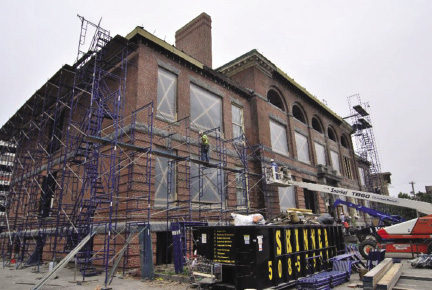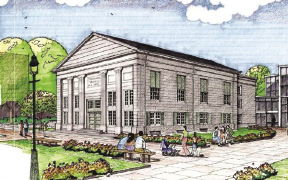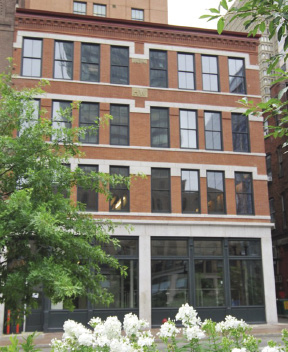With its rich architectural history, Boston and its surrounding communities are home to a vast array of buildings that are well-suited to be re-developed while preserving their historical significance. Beginning with early examples of well-known structures like Boston City Hall's conversion into restaurant and office space in 1969 and Faneuil Hall's transformation into a popular tourist/retail destination in 1970, there is an extensive list of outdated buildings that have been adapted for new purposes. Lesser known but historically significant buildings also populate the list, such as the 1874 Henry Willis Building at 175 Purchase St. in the Financial District which Nauset Construction recently converted into the new Brazilian Consulate for owner 175 Purchase Street LLC, an affiliate of Core Investments Inc. The building is expected to be approved by the National Register of Historic Places in 2014. Obsolete mills, factories, and schools with less historical significance but structurally sound have also been re-purposed as office, industrial, retail and multi-family properties throughout New England.
The positives for re-purposing historic buildings are numerous, beginning with the building's coveted rich history. Historic buildings often have a great story to tell and provide educational, economic, religious and architectural resources that reflect the community's
transition from past to present. Many historic buildings are also located in the heart of their community, adjacent to centers of government, commerce and education which make them attractive for new Smart Growth initiatives.
And from an economic perspective, the architectural features, materials and craftsmanship would be cost-prohibitive to replicate in today's market. Lastly, the impact of renovating existing versus demolishing and disposal provides long-term benefits to our environment.
"If you have a building that's clearly of architectural value, the chance that you're going to get something as good or better in its place is highly unlikely," said Dr. Ed Fitzgerald, executive director of the Quincy Historical Society and a member of the Quincy Historical Commission. But Fitzgerald cautions that not all historic buildings are appropriate for repurposing, a point that is well illustrated in the historically rich City of Quincy, home to over 100 buildings listed with the National Register of Historic Places - many of which have outlived their original use.
Three historically significant buildings in the City of Quincy were recently considered for adaptive re-use, but only two made the grade while the other was demolished. Old City Hall (a Classic Greek Revival building built in 1844 and on the National Register of Historic Places) was in disrepair and had problems with the masonry, windows and roof plus heating, lighting, and building code issues, however the restoration was approved based on its solid structure and aesthetic qualities. Conversely, the old Quincy High School was considered a historically significant component of the Quincy Center Local Historic District, yet was demolished due to structural and re-purposing issues.
Coddington Hall, built in 1908 as an elementary school and designed by Charles Brigham architect for the Museum of Fine Arts in Boston, was not such an easy decision. The building had been previously adapted for many purposes (including as home to Quincy College), but is in need of much work - exterior masonry restoration, a new slate roof and copper gutters, new windows, a new metal fascia, soffit and dentils, plus asbestos abatement. The combination of its historical value and structural soundness makes it suitable for a practical use and is now being converted to house Quincy's school administration as well as the City's information technology functions.
"City Hall was a slam dunk to save because of the history and its prominence, but Coddington Hall was a challenge because some people did not see it as historically important," said Stephen Wessling, CEO of Wessling Architects (which provided preservation and interior design services for the project) and also a board member of Preservation Massachusetts. "But we did our research and saw that we could move all of the city departments into the Coddington and it would be an outstanding adaptive re-use of the building."
Developers seeking to embrace the adaptive re-use method should be aware of the delicate balancing act that exists between the advantages of repurposing older buildings and the economic viability of a given project. The key to a successful redevelopment of an existing building comes down to how much investigative work the developer is willing to perform beforehand, and whether he is willing to commit the capital necessary to conduct proper and thorough due diligence.
Pre-construction, design and planning are absolutely imperative elements as any owner who has failed to plan for contingencies on a similar project can attest. This begins with a thorough pre-construction survey that includes extensive soil and building testing for contaminants, a structural analysis and building envelope study - which often requires exploratory work in walls, roof and foundation systems to mitigate unforeseen conditions. Another consideration is whether the building can be upgraded to an acceptable level of energy efficiency. For instance, the Coddington Hall project team initially had concerns about the ability to effectively insulate the building's masonry walls, but they were able to achieve efficiency through the use of high performance closed-cell (spray) insulation and energy efficient windows.
Experienced developers also know they must work in harmony with local historic commissions, as many projects have been delayed when artifacts have been found and need to be collected and documented for preservation. Those seeking to reduce their overall costs via historic tax credits and preservation grants should be aware that historic commissions' criteria can vary widely by locale and can be a challenging and often time-consuming process.
Adaptive re-use of historic buildings preserves history while revitalizing neighborhoods and developers that are willing to perform proper due diligence can reap enormous benefits while also serving our communities. The historic renovation process also minimizes the impact on the environment and can yield financial incentives in forms of energy and tax credits to help support building restoration costs. While adaptive re-use development is not without its challenges, the rewards to developers, occupants and the community at large are innumerable as we breathe new life into our rich historical past.
Anthony Papantonis is president of Nauset Construction Corp., Quincy, Mass.
 (1).jpg)











.png)